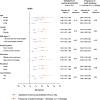Prevalence, General and Periodontal Risk Factors of Gastroesophageal Reflux Disease in China
- PMID: 36691403
- PMCID: PMC9863457
- DOI: 10.2147/JIR.S395777
Prevalence, General and Periodontal Risk Factors of Gastroesophageal Reflux Disease in China
Abstract
Purpose: There is insufficient information about the prevalence and risk factors of gastroesophageal reflux disease (GERD) in the Chinese adult population. We aimed to assess the prevalence and identify the risk factors of GERD in China.
Methods: We collected data from a nationally representative sample (50,991 subjects) of Chinese adults from a large nation-wide cross-sectional survey. GERD was diagnosed by a standardized Chinese-language GERD questionnaire with a score of ≥ 8. The demographic characteristics, comorbidities and periodontal factors of all participants were collected.
Results: Fifty-thousands-one-hundred-eighty-three participants were finally included in this study. The overall prevalence of GERD was 5.6% (95% CI, 5.4-5.8%) among the general Chinese population aged 20 years or older. Women, smokers, and people with older age, BMI ≥ 25.0 kg/m2, urban residence, lower education level or comorbidities were more prevalent with GERD (p < 0.001). Symptoms of severe periodontitis (OR = 1.40, 95% CI 1.28-1.52, p < 0.001) and lower frequency of tooth brushing (OR = 2.01, 95% CI 1.76-2.29, p < 0.001) were significantly associated with risk of GERD.
Conclusion: Symptom-based GERD is highly prevalent in the Chinese population. Overweight and smoking are major preventable risk factors for GERD. Periodontal factors are novel potential risk factors for GERD and should be given more attention in GERD prevention.
Keywords: epidemiology; gastroesophageal reflux disease; periodontitis; prevalence; risk factor.
© 2023 Liu et al.
Conflict of interest statement
The authors declare that they have no conflicts of interest in this work.
Figures




Similar articles
-
Incidence of gastroesophageal reflux disease in Uygur and Han Chinese adults in Urumqi.World J Gastroenterol. 2012 Dec 28;18(48):7333-40. doi: 10.3748/wjg.v18.i48.7333. World J Gastroenterol. 2012. PMID: 23326142 Free PMC article.
-
Physical activity, obesity and gastroesophageal reflux disease in the general population.World J Gastroenterol. 2012 Jul 28;18(28):3710-4. doi: 10.3748/wjg.v18.i28.3710. World J Gastroenterol. 2012. PMID: 22851863 Free PMC article.
-
Prevalence, risk factors and impact of gastroesophageal reflux disease symptoms: a population-based study in South China.Scand J Gastroenterol. 2005 Jul;40(7):759-67. doi: 10.1080/00365520510015610. Scand J Gastroenterol. 2005. PMID: 16118911
-
Prevalence of gastro-esophageal reflux disease and its risk factors in a community-based population in southern India.BMC Gastroenterol. 2016 Mar 15;16:36. doi: 10.1186/s12876-016-0452-1. BMC Gastroenterol. 2016. PMID: 26979399 Free PMC article.
-
Lifestyle Modifications in Adults and Older Adults With Chronic Gastroesophageal Reflux Disease (GERD).Crit Care Nurs Q. 2019 Jan/Mar;42(1):64-74. doi: 10.1097/CNQ.0000000000000239. Crit Care Nurs Q. 2019. PMID: 30507666 Review.
Cited by
-
Potential Risks Associated With Long-term Use of Proton Pump Inhibitors and the Maintenance Treatment Modality for Patients With Mild Gastroesophageal Reflux Disease.J Neurogastroenterol Motil. 2024 Oct 30;30(4):407-420. doi: 10.5056/jnm24059. J Neurogastroenterol Motil. 2024. PMID: 39397619 Free PMC article. Review.
-
The short-term effect of laparoscopic sleeve gastrectomy with his angle reconstruction (LSG-His) on gastroesophageal reflux disease.BMC Gastroenterol. 2025 Aug 21;25(1):611. doi: 10.1186/s12876-025-04216-z. BMC Gastroenterol. 2025. PMID: 40841928 Free PMC article.
-
Association of gastroesophageal reflux disease with the incidence of pulmonary disease.Front Cell Dev Biol. 2025 Jul 23;13:1552126. doi: 10.3389/fcell.2025.1552126. eCollection 2025. Front Cell Dev Biol. 2025. PMID: 40772230 Free PMC article.
-
Dental evaluation is helpful in the differentiation of functional heartburn and gastroesophageal reflux disease.World J Gastroenterol. 2023 Aug 21;29(31):4774-4782. doi: 10.3748/wjg.v29.i31.4774. World J Gastroenterol. 2023. PMID: 37664156 Free PMC article.
-
Current Status of Dental Examinations During Pregnancy Term in Matsudo City, Japan.Cureus. 2025 Mar 13;17(3):e80533. doi: 10.7759/cureus.80533. eCollection 2025 Mar. Cureus. 2025. PMID: 40225493 Free PMC article.
References
LinkOut - more resources
Full Text Sources

